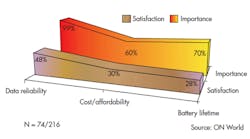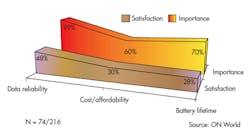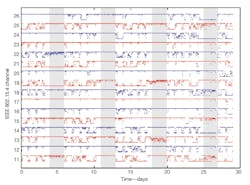This file type includes high resolution graphics and schematics.
Wireless sensing systems can provide information about the physical world that enable new levels of efficiency, safety, and security, especially when those systems can be implemented with the lowest power consumption possible. Wireless sensing networks offer the flexibility of sensor placement that is simply not possible with wired systems. And by minimizing power consumption, wireless sensing systems can be deployed with dramatic cost reductions compared to traditional wired sensing systems.
Low power wireless sensor networking (WSN) standards, particularly mesh architectures that utilize time-synchronized channel hopping (TSCH), enable every node in the network to run on batteries or harvested energy without sacrificing reliability or data throughput. This frees application developers to put sensors anywhere—not just where power is available, but wherever the application requires sensor data. Linear Technology, in particular the firm’s Dust Networks product group, has been pursuing advances in the areas of highly reliable, low power TSCH-based WSN and energy harvesting technologies. Such technologies go hand in hand to increase opportunities for application developers to deploy systems that require few (if any) battery changes, further reducing the lifetime cost of deploying wireless sensors and spurring the progress of the Internet of Things (IoT).
A 2012 study by ON World shows that the two attributes of a WSN that matter most to industrial customers are reliability and low power consumption (Fig. 1). Third on the list is cost: Without solving the reliability and power issues, cost is not yet a customer priority. Based on Dust Networks’ years of research and development of TSCH-based products and deployment of thousands of commercial products, it is clear that the combination of precisely synchronized time slotting, channel hopping, and an ultralow power radio enables the lowest power, most reliable WSNs. This focus on low power consumption enables all nodes to run for many years on low-cost batteries, and also opens possibilities for a variety of energy sources—including energy-harvesting supplies.
1. This diagram (from ON World) shows the perceived importance of different WSN attributes.
Introduction of the IEEE 802.15.4 standard created an excellent radio platform for WSNs. The IEEE 802.15.4 standard defines a 2.4-GHz, 16-channel spread-spectrum low-power physical (PHY) layer upon which many IoT technologies have been built, including ZigBee and WirelessHART. It also defines a medium-access-control (MAC) layer, which has been the foundation of ZigBee. Unfortunately, the single-channel nature of this MAC makes its reliability unpredictable. For improved reliability, the WirelessHART protocol, also known as IEC62591, defines a multichannel link layer based on the 15.4 MAC layer, which helps achieve the high reliability (better than 99.9%) needed for industrial WSN applications.
In early 2012, a new version of the IEEE 802.15.4 MAC, called IEEE 802.15.4e, was ratified; this MAC embodies multichannel mesh and time slotting. The typical power output for IEEE 802.15.4-compliant radios is around 0 dBm. These radios operate with transmit and receive current in the 15-30-mA range. The best-in-class operating conditions include transmit current of only 5.4 mA for a transmit power level of 0 dBm and receive current of only 4.5 mA (based on an LTC5800 device operating from 2400.0 to 2483.5 MHz).
The original IEEE 802.15.4 MAC necessitates that the nodes in the mesh network that route information from neighboring nodes are always on, while nodes that only send/receive their own data, often called “reduced function devices,” can sleep between transmissions. In order for every node in the network to be low power, communications between nodes must be scheduled, and it is necessary to have a shared sense of time in the network. The tighter the synchronization, the less time the routing node radios must be in an “on” state, which minimizes power consumption.
Best-in-class TSCH systems synchronize all nodes in a multi-hop mesh network to within a few tens of microseconds. Once there is a shared sense of accurate time in the network—and a schedule of time slots for pairwise transmission between nodes in the network—channel assignment can be incorporated into that schedule, thereby enabling channel hopping.
Wireless channels are not perfect or ideal, of course, and numerous conditions can prevent a transmitted signal from being fully recovered by a receiver. As radio power decreases, wireless reception can become even more difficult. For example, interference can occur when multiple transmitters send signals simultaneously over the same frequency. This is particularly problematic if the different systems cannot hear each other, but the intended receiver can hear all of the transmitted signals (the “hidden terminal problem”). Backoff, retransmission, and acknowledgment mechanisms are required to resolve collisions from multiple transmitted signals within the same frequency band. Interference can come from within the network, from another similar network operating in the same radio space, or from a different radio technology operating within the same frequency band. The latter is a common occurrence in the 2.4-GHz band shared by Wi-Fi, Bluetooth, and IEEE 802.15.4.
A second, unpredictable phenomenon called multipath fading can prevent successful transmission even when the line-of-sight link margin is expected to be sufficient. This occurs when multiple copies of the transmission bounce off objects in the environment (ceilings, doors, people, etc.), with each reflected copy traveling a different distance. When interfering destructively, fades as deep as 20 to 30 dB are common. Multipath fading depends on the transmission frequency, device position, and on the nearby objects that can act as reflectors; predicting the amount of fading for any environment is difficult if not impossible.
This file type includes high resolution graphics and schematics.
Figure 2 shows the packet delivery ratio on a single wireless path between two industrial sensors over the course of 26 days, and for each of the 16 channels used by the system. At any given time, some channels are good (high delivery), others bad, and still others highly varying. Importantly, there was no period observed where a channel was good on all paths everywhere in the network.
2. Data acquired over 26 days shows the breakdown of packet delivery across the 16 channels of a WSN.
To overcome fading, multipath effects, and other conditions that can degrade radio performance, it is critical that WSNs employ multiple channels. By time-synchronizing and scheduling the network into slots, transmissions can be precisely scheduled on specific known channels, and the choice of channel can change with every transmission. Furthermore, scheduling network transmissions can solve the hidden terminal problem and virtually eliminate in-network collisions. Such a mechanism has been proven successful in more than 10,000 WirelessHART networks in the field, which routinely achieve multiyear battery life and greater than 99.9% reliability.
In laying out a WSN node, once its power requirements have been suitably minimized, greater flexibility is possible when choosing a power source for the node. If the power requirements are sufficiently low, it may be possible to power a WSN from any number of sources. For example, ambient energy is everywhere: Light, vibration, and heat are but a few examples of energy that can be freely sourced and converted to sufficient electrical energy to run a low-power TSCH WSN. The following examples illustrate some practical energy-harvesting technologies that can generate more than 150 μW power—more than enough power to run a typical IPv6 routing node in an IEEE 802.15.4e network (for example, Dust Networks’ SmartMesh™ IP product).
Most areas within a typical office building have sufficient indoor light to run a low-power TSCH WSN. According to the United States General Services Administration, which sets the guidelines for US public buildings, the more brightly lit areas, such as workstation areas and reading surfaces, enjoy 500 lux of lighting. Even areas considered “normally lit”—such as lobbies, stairwells, and mechanical and communications closets—have at least 200 lux light, while 300 lux light is common for most conference rooms. Given 200 to 300 lux light, a number of small photovoltaic cells are available for indoor applications. These include the model 4100 photovoltaic power module from G24i and the AM-1815 indoor cell from Sanyo, both of which are capable of supplying sufficient power to operate an IPv6 router in an IEEE 802.15.4e TSCH network.
Thermal electric generators (TEGs) produce power from heat dissipation, typically working with hot surfaces, such as waste heat from common devices normally thought of as very warm (e.g., computer monitors or high-current motors). As wireless solutions become more power efficient, the energy produced from commonplace temperature differences of as little as 10°C become usable as energy sources. As a reference, the typical difference between the internal body temperature and room temperature is about 15°C.
Many energy harvesting transducers produce only a few hundred millivolts of output, so step-up voltage DC/DC converters are often required to convert these outputs to a usable supply voltage range. Integrated circuits (ICs) such as the model LTC3105 from Linear Technology combine maximum power point control, so that the transducers operate at peak efficiency. The LTC3105 also enables the addition of a battery backup to the circuit. Since the batteries in these circuits are only used when the ambient energy source is insufficient or absent, battery life can be extended dramatically, thus reducing the costs associated with changing batteries. Conversely, the inclusion of battery backups to an energy harvested circuit can provide added assurance and power continuity if the energy source happens to be intermittent (e.g., if lights, or machinery are turned off for the weekend).
The IoT is being given a healthy boost through the availability of wireless sensors. Reliable, low-power WSNs are putting customers and developers at ease. Time synchronized, slotted multichannel systems confer customer-critical benefits to WSNs: reliability and network-wide low power operation. The WirelessHART and IEEE 802.15.4e standards are excellent embodiments of this networking approach. Low-power operation ensures great flexibility in the choice of power source, and offers the potential for perpetual power. These factors all add up to making it easier and more practical to put useful sensors anywhere.
Joy Weiss, President
Ross Yu, Product Marketing Manager
Jonathan Simon, Systems Engineering Director
Dust Networks Product Group
Linear Technology Corp., 1630 McCarthy Blvd., Milpitas, CA 95053; (408) 432-1900, www.linear.com.
This file type includes high resolution graphics and schematics.



